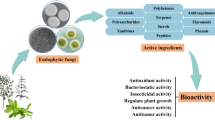Abstract
Objective
To investigate the antifungal activity and possible mechanism of tea polyphenols (TPs) against Rhizopus stolonifer, the agent of rotting in nectarines and peaches.
Results
TP inhibited both mycelial growth and spore germination in vitro in a dose-dependent manner, and the morphological changes of the treated hyphae with TP, such as irregularly swollen, increased branching, wrinkled, entwining, collapse and breakage, and of the treated spores, such as swelling of germ tube tips, exfoliation of the surface layer and disorganization of cell organelles, were observed using optical microscopy, scanning electron microscopy and transmission electron microscopy. TP also significantly decreased rhizopus rot on inoculated nectarines and induced the activities of phenylalanine ammonia lyase, polyphenol oxidase, peroxidase, chitinase, and β-1,3-glucanase.
Conclusion
The mechanism of action might be attributed to direct damage of the mycelium and spore and indirect induction of defensive enzyme activities. TP has the potential to be developed as an alternative to control post-harvest disease of fruit caused by R. stolonifer.




Similar content being viewed by others
References
Bonaterra A, Mari M, Casalini L, Montesinos E (2003) Biological control of Monilinia laxa and Rhizopus stolonifer in post-harvest of stone fruit by Pantoea agglomerans EPS125 and putative mechanisms of antagonism. Int J Food Microbiol 84:93–104
Chen JJ, Zhang SS, Yang XP (2013) Control of brown rot on nectarines by tea polyphenol combined with tea saponin. Crop Prot 45:29–35
Dong CH, Yao YJ (2005) Nutritional requirements of mycelial growth of Cordyceps sinensis in submerged culture. J Appl Microbiol 99:483–492
Fan Q, Tian SP (2000) Postharvest biological control of rhizopus rot of nectarine fruits by Pichia membranefaciens. Plant Dis 84:1212–1216
Farkaš V (1985) The fungal cell wall. In: Peperdy JF, Ferenzy L (eds) Fungal protoplasts, application in biochemistry and genetics. Marcel Dekker, Inc., New York, pp 3–29
Förster H, Driever GF, Thompson DC, Adaskaveg JE (2007) Postharvest decay management for stone fruit crops in California using the “reduced-risk” fungicides fludioxonil and fenhexamid. Plant Dis 91:209–215
Hernández-Lauzardo AN, Bautista-Baños S, Velázquez-del Valle MG, Méndez-Montealvo MG, Sánchez-Rivera MM, Bello-Pérez LA (2008) Antifungal effects of chitosan with different molecular weights on in vitro development of Rhizopus stolonifer (Ehrenb.:Fr.) Vuill. Carbohydr Polym 73:541–547
Hirasawa M, Takada K (2004) Multiple effects of green tea catechin on the antifungal activity of antimycotics against Candida albicans. J Antimicrob Chemother 53:225–229
Hsieh C, Liu CJ, Tseng MH, Lo CT, Yang YC (2006) Effect of olive oil on the production of mycelial biomass and polysaccharides of Grifola frondosa under high oxygen concentration aeration. Enzyme Microb Technol 39:434–439
Ji C, Kuć J (1996) Antifungal activity of cucumber β-1,3-glucanase and chitinase. Physiol Mol Plant Pathol 49:257–265
Jing W, Tu K, Shao XF, Su ZP, Zhao Y, Wang S, Tang J (2010) Effect of post-harvest short hot-water rinsing and brushing treatment on decay and quality of strawberry fruit. J Food Qual 33:262–272
Kretschmer S (1978) Kinetics of vegetative growth of Thermoactinomyces vulgaris. Z Allg Mikrobiol 18:701–711
Kubo I, Himejima M (1992) Potentiation of antifungal activity of sesquiterpene dialdehydes against Candida albicans and two other fungi. Cell Mol Life Sci 48:1162–1164
Liu HM, Guo JH, Cheng YJ, Liu P, Long CA, Deng BX (2010) Inhibitory activity of tea polyphenol and Hanseniaspora uvarum against Botrytis cinerea infections. Lett Appl Microbiol 51:258–263
Liu H, Tian W, Li B, Wu G, Ibrahim M, Tao Z, Wang Y, Xie G, Li H, Sun G (2012) Antifungal effect and mechanism of chitosan against the rice sheath blight pathogen, Rhizoctonia solani. Biotechnol Lett 34:2291–2298
Sisler HD, Ragsdale NN (1984) Biochemical and cellular aspects of antifungal action of ergosterol biosynthesis inhibitors. In: Trinci APJ, Riley JF (eds) Mode of action of antifungal agents. Cambridge University Press, Cambridge, pp 257–281
Sitheeque MAM, Panagoda GJ, Yau J, Amarakoon AMT, Udagama URN, Samaranayake LP (2009) Antifungal activity of black tea polyphenols (catechins and theaflavins) against Candida species. Chemotherapy 55:189–196
Soylu EM, Kurt Ş, Soylu S (2010) In vitro and in vivo antifungal activities of the essential oils of various plants against tomato grey mould disease agent Botrytis cinerea. Int J Food Microbiol 143:183–189
Stevens C, Khan VA, Wilson CL, Lu JY, Chalutz E, Droby S (2005) The effect of fruit orientation of post-harvest commodities following low dose ultraviolet light-C treatment on host induced resistance to decay. Crop Prot 24:756–759
Toyoshima Y, Okubo S, Toda M, Hare Y, Shimamura T (1993) Effect of catechin on the ultrastructure of Trichophyton mentagrophytes. Kansenshogaku Zasshi 68:295–303
Tzortzakis NG, Economakis CD (2007) Antifungal activity of lemongrass (Cymbopogon citrates L.) essential oil against key post-harvest pathogens. Innov Food Sci Emerg Technol 8:253–258
Xu WT, Huang KL, Guo F, Qu W, Yang JJ, Liang ZH, Luo YB (2007) Postharvest grapefruit seed extract and chitosan treatment of table grapes to control Botrytis cinerea. Postharvest Biol Technol 46:86–94
Yang XP, Jiang XD, Chen JJ, Zhang SS (2013) Control of post-harvest grey mould decay of nectarine by tea polyphenol combined with tea saponin. Lett Appl Microbiol 57:502–509
Acknowledgments
This work was financially supported by the Fundamental Research Funds for the Central Universities, China (Grant No. 2013PY091) and the Natural Science Foundation of Hubei Province, China (Grant No. 2011CDB136).
Author information
Authors and Affiliations
Corresponding author
Rights and permissions
About this article
Cite this article
Yang, X., Jiang, X. Antifungal activity and mechanism of tea polyphenols against Rhizopus stolonifer . Biotechnol Lett 37, 1463–1472 (2015). https://doi.org/10.1007/s10529-015-1820-6
Received:
Accepted:
Published:
Issue Date:
DOI: https://doi.org/10.1007/s10529-015-1820-6




